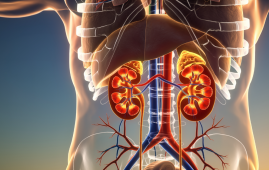

More than gestational diabetes mellitus, maternal obesity affects the formation of the placenta, a crucial organ that nourishes the unborn child during pregnancy (GDM; a condition characterized by poor glucose control in pregnancy).
The new information, which was published in The Journal of Physiology, advances knowledge of the mechanisms driving unfavorable pregnancy outcomes and the increased likelihood of unfavorable neonatal and child health that follows. In low-middle-income nations, particularly, the discovery of unique placental alterations may pave the way for the eventual creation of screening procedures or medicines that specifically target the placenta.
The study, which was carried out by South African and English scientists in collaboration, is the first to look at the effects of maternal obesity and GDM at the same time and to be conducted in a nation with a low-middle income, where obesity and GDM during pregnancy have a significant negative impact on both health and the economy. Past research has only been conducted in high-income nations and has only looked into obesity and GDM separately.
Globally, the prevalence of obesity and GDM—the occurrence of impaired glucose control during pregnancy—is rising. Both have been connected to a number of maternal and fetal issues, including a higher risk of fetal mortality, stillbirth, infant death, and low birth weight in the baby. The cause of these problems is unknown.
The capacity of the placenta to exchange nutrients between the mother and developing child was discovered to be lessened by maternal obesity than by gestational diabetes mellitus (GDM). Inflammation indicators and placental hormone synthesis are both impacted by GDM and obesity, indicating that the placenta is really behaving improperly.
71 women of mixed or black ancestry were examined in the study. 52 of them were obese, and 38 of them had GDM. In order to assess the impact of obesity and GDM on this group of pregnant women, the researchers conducted the study using clinical profiling, in-depth structural examination and molecular analysis of the placenta, and biochemical measures of maternal and infant cord blood.
Lead author Professor Amanda Sferruzzi-Perri of the University of Cambridge said, “For the first time we have looked at the effects of both obesity and GDM on the placenta in black and mixed-ancestry woman, who are an understudied group, and what effect that these conditions might have on them and their children. It was important to discover that obesity has more of an influence than GDM on pregnancy outcomes for both the mother and the child.”
The study’s main disadvantage is the limited sample size of only 71 women, which made it impossible to ascertain the effect of the fetus’ gender on these placental changes. Women who would be classified as overweight were also included in the non-obese category of women. The impact of the fetus’ gender will be investigated in additional studies on obese, overweight, and lean mothers with and without GDM. In order to predict pregnancy outcomes and the long-term health of the fetus, researchers are interested in examining the interactions between obesity, GDM, and therapies such as the blood glucose-lowering medicine metformin.
Lead co-author Professor Mushi Matjila of the University of Cape Town said, “South Africa is burdened by a quadruple disease burden of communicable and non-communicable disease, along with high maternal and child morbidity and mortality, and deaths related to violence and injuries. Additionally, we have one of the highest rates of female obesity globally, which undoubtedly fuels the non-communicable disease burden and contributes to maternal, neonatal, and child morbidity. As obesity and GDM often coexist, the study highlights the importance of obesity over GDM in modulating placental structure and function, and begins to piece together how these placental changes may explain observed complications (e.g., intrauterine death and stillbirths) and increased future non-communicable disease risk for both mother and baby.”
more recommended stories
 E-Cigarette Use and Heart Attack Risk in Former Smokers
E-Cigarette Use and Heart Attack Risk in Former SmokersKey Takeaways for Clinicians and Nurses.
 Ultramarathon Physiology: What HCPs Should Know?
Ultramarathon Physiology: What HCPs Should Know?Ultramarathon Metabolism: What Happens to the.
 High-Intensity Training and Oxidative Stress Insights
High-Intensity Training and Oxidative Stress InsightsNew Evidence Linking High-Intensity Training and.
 Sterilized Fermented Beverage for Obesity: New Evidence
Sterilized Fermented Beverage for Obesity: New EvidenceEarly Insights Into a Sterilized Fermented.
 36-Week Pre-eclampsia Screening May Reduce Term Risk
36-Week Pre-eclampsia Screening May Reduce Term RiskA New Preventive Strategy for Term.
 Cardiovascular Risk and Sudden Cardiac Death in Diabetes
Cardiovascular Risk and Sudden Cardiac Death in DiabetesRising Sudden Cardiac Death (SCD) Risk.
 Poor Kidney Function and Alzheimer’s Biomarkers Explained
Poor Kidney Function and Alzheimer’s Biomarkers ExplainedPoor kidney function may influence levels.
 Perinatal Mental Health Challenges Highlighted in New Study
Perinatal Mental Health Challenges Highlighted in New StudyMental Health Challenges in New Parents:.
 Walking Speed Before Hip Replacement Predicts Recovery
Walking Speed Before Hip Replacement Predicts RecoveryNew Evidence Points to a Simple,.
 Neuroblastoma Drug Combo Extends Survival in Models
Neuroblastoma Drug Combo Extends Survival in ModelsA Promising Shift in High-Risk Neuroblastoma.

Leave a Comment